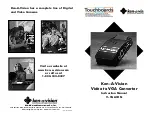
Photography: what other field has so
many terms for failure? Photos can
fail by being out of focus. Or due to
camera-shake. Or because of under-
exposure, or over-exposure, or
a million other things. The evolution
of the camera has been, essentially,
a fight against photographic failure.
Thanks to all this failure-averse
technological development, today's
highly-evolved digital cameras are
almost failure-proof: anyone can take
a decent photo with no effort at all.
The fully-automatic mode of the
average digital camera includes
automatic flash: based on what
it detects about the subject,
the camera grabs the image least
likely to fail. Even the dreaded
camera-shake can now be eliminated
by technology. Noise-reduction,
which almost completely banishes
noise, even in high-sensitivity
photography, has also made stunning
leaps in the last few years.
Better technology means the
market is now overflowing with
cameras guaranteeing a certain level
of competence to all users, from
beginners to press photographers
who cannot afford to fail.
Of course, this evolution has brought
some immeasurable blessings.
It's made a major contribution to the
widespread adoption of cameras and
the development of photographic
culture. And of course, Sigma has
been at the forefront. Today, as
ever, we're working on all sorts of
proprietary technologies.
We certainly don't intend to loosen
our grip on the state of the art.
But at the same time we note that the
pictures resulting from this failure-
averse technology have a certain air
of flatness and lifelessness. A certain
sameness— whatever their subject.
And a certain lack of expressiveness.
Not everyone would agree that the
only "good" photographs are slick,
catalog-style pictures, every inch
impeccably lit, and with not a single
flaw. A photo may be slightly too
low-key, slightly too high-key, or
a little blurred, yet still have its own
distinctive charm. In fact, when it
comes to expressing the emotion that
moved the photographer to press the
shutter, a technically-flawed photo
may actually be more eloquent and
vivid. That's how infinitely varied the
world of photographic expression is.
You've probably heard the
following apocryphal story. There's
a photographer who takes really
distinctive photos. He uses a single-
focus lens mounted on a simple
manual film camera. It doesn't even
have a program mode. One day
he gets an up-to-the-minute digital
camera with a fully-automatic mode.
That's the day he loses all interest
in photography. So the story goes.
Its moral? If you perfect all the
extra functions intended to provide
convenience for all users, delivering
a camera that captures nothing but
uniformly competent photos,
you can end up purging photography
of all individuality. Draining it
of emotionally-charged natural
inspiration. That's the last thing
Sigma wants to do. To us, a camera
isn't a tool for recording an infinite
series of acceptable images. It's an aid
in translating an irreplaceable instant
into a work of art of the highest order.
Our efforts to attain this ideal have
culminated in the DP1.
The Next Dimension :
A Camera with Principles.
03




































